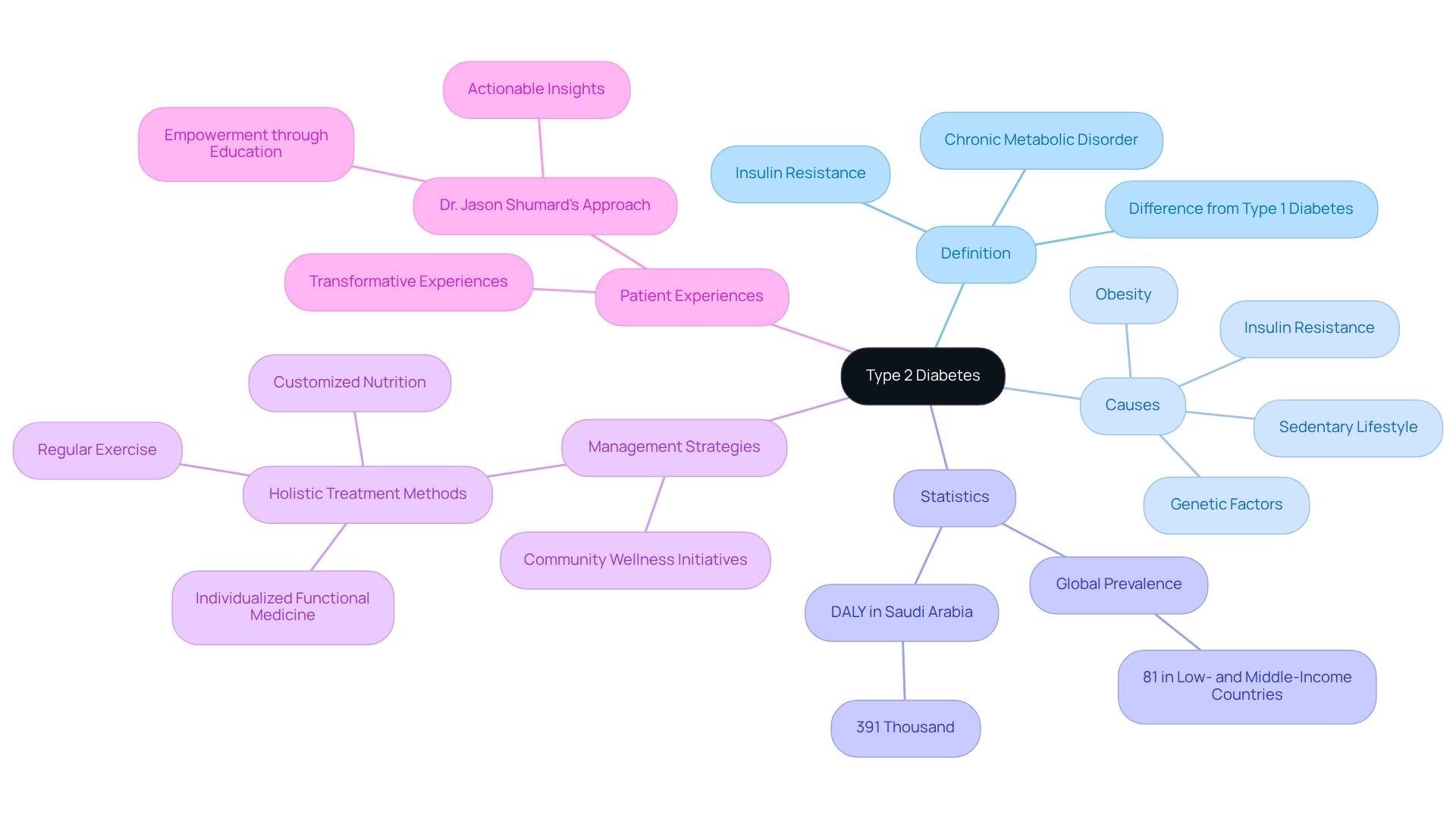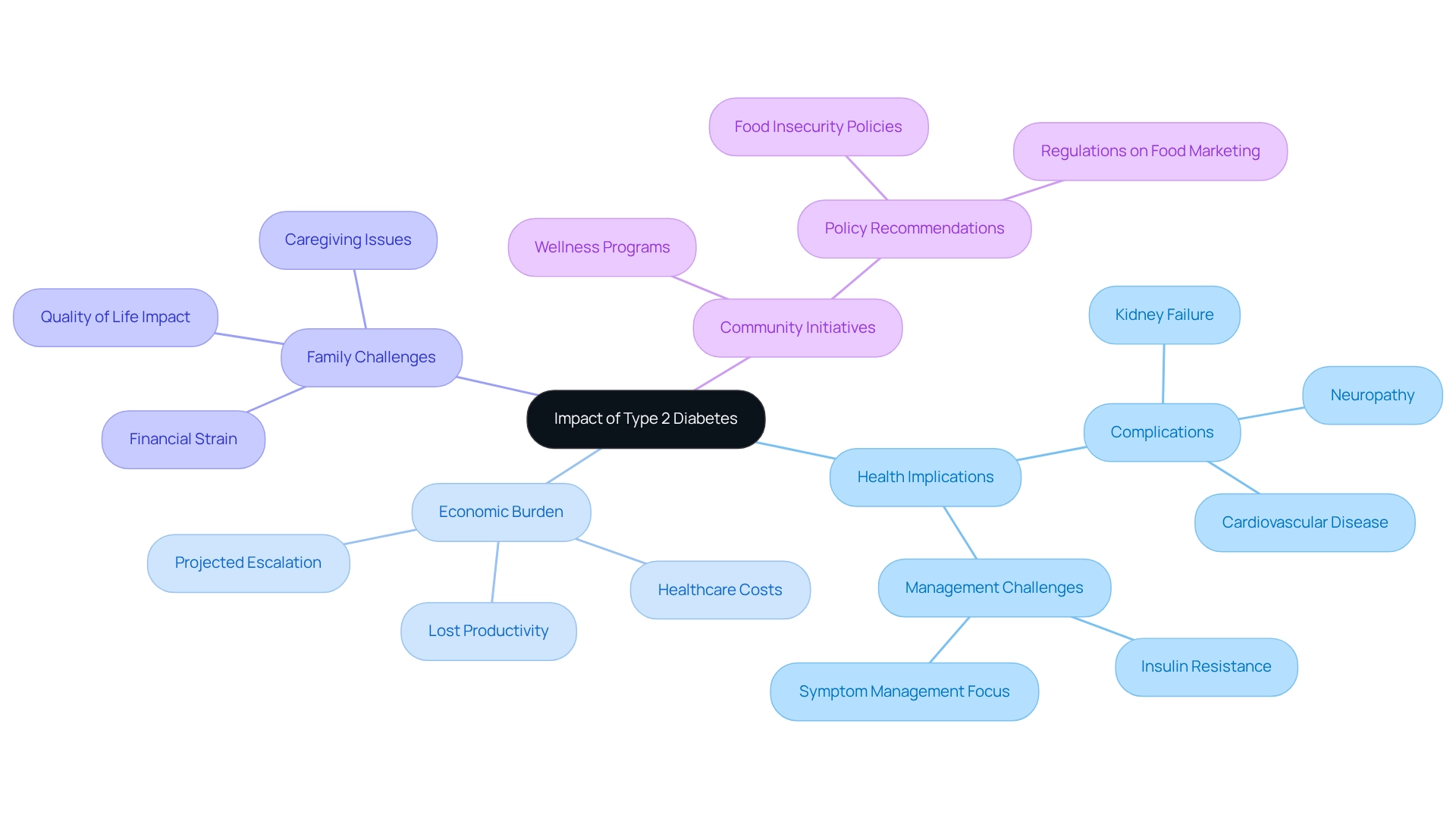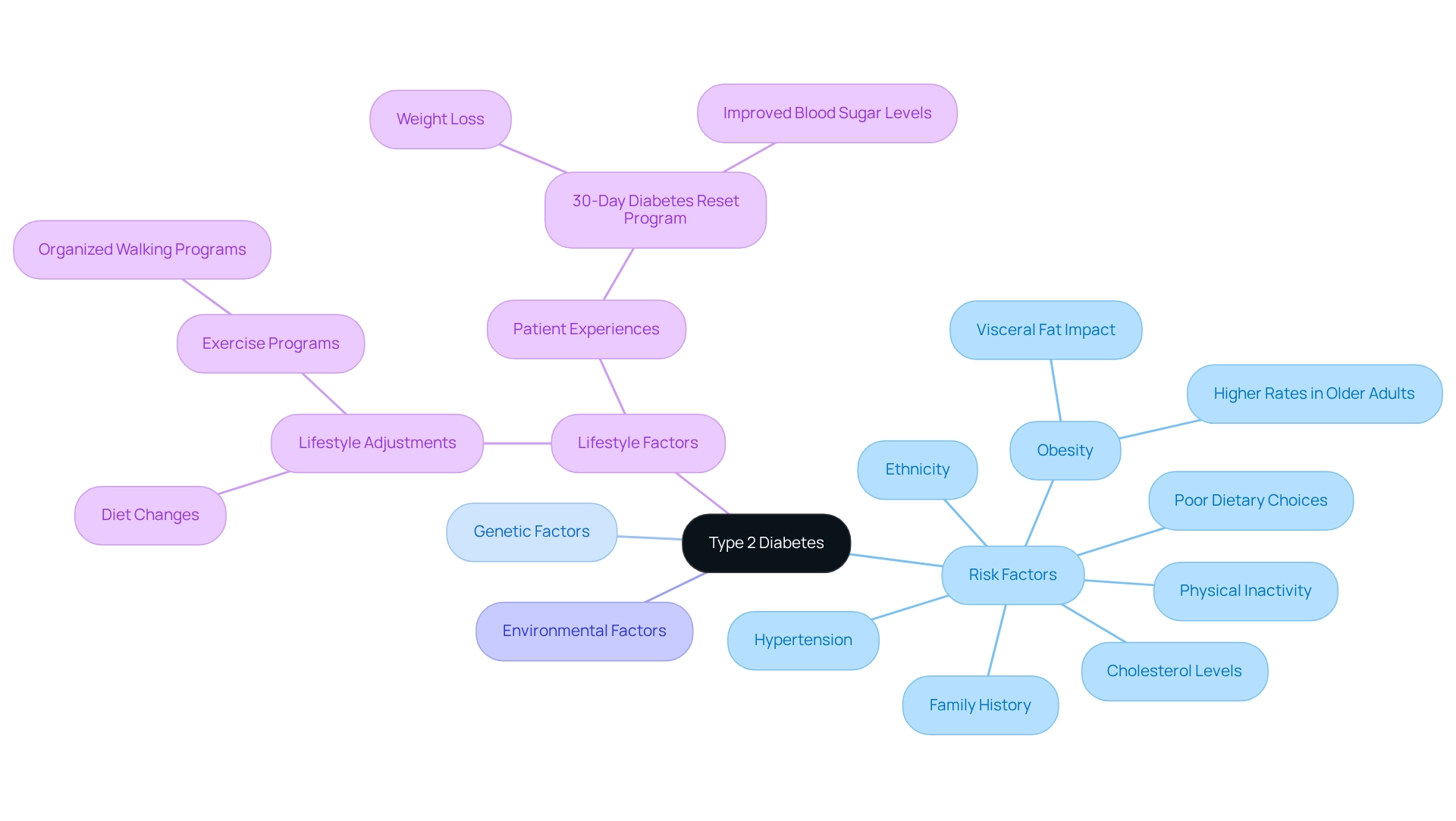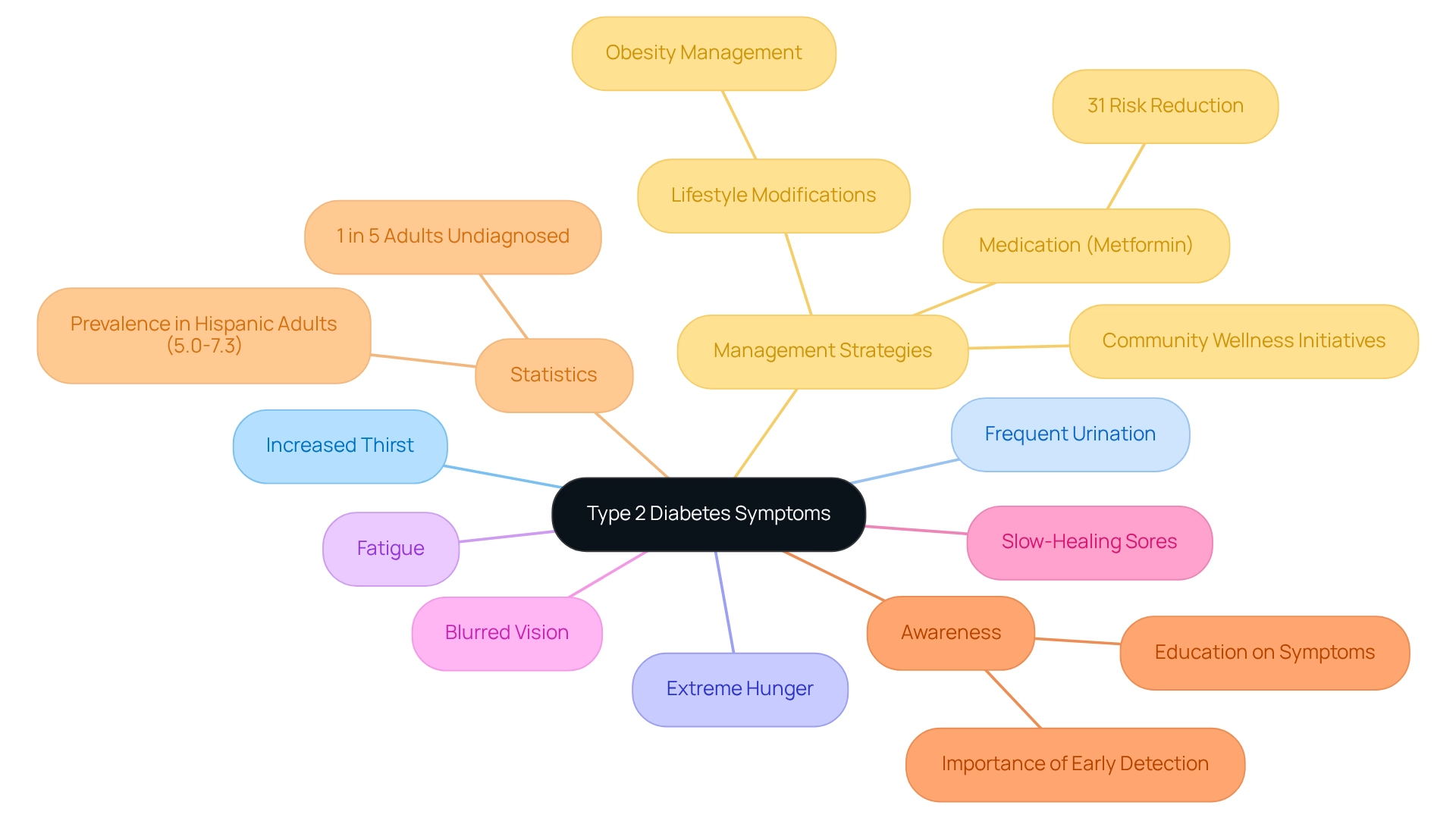Overview
Living with Type 2 diabetes can be challenging. It’s a chronic metabolic disorder where insulin resistance means your body’s cells struggle to respond effectively to insulin, resulting in elevated blood sugar levels. Many individuals face a combination of genetic, environmental, and lifestyle factors that contribute to this condition. It’s important to recognize that managing diabetes is not just about medication; it requires a comprehensive approach.
This journey often calls for significant lifestyle changes and personalized care. By embracing these changes, you can mitigate the impact of diabetes on your health and well-being. Many patients find that small, consistent adjustments lead to meaningful improvements. Remember, you are not alone in this; support is available.
Have you considered how your daily habits affect your diabetes management? Reflecting on this can be a powerful step toward a healthier life. Engaging in the 30-Day Diabetes Reset program could be a great way to start your journey toward better health. Together, we can work towards making positive changes that resonate with your unique needs.
Introduction
In a world where lifestyle choices and genetic predispositions intertwine, type 2 diabetes emerges as a significant health crisis, impacting millions across the globe. This chronic metabolic disorder, marked by insulin resistance, often sneaks in without notice, with symptoms that can be easily overlooked.
It’s important to recognize that as the prevalence of this condition continues to rise, especially in low- and middle-income countries, understanding its complexities becomes increasingly vital.
From the underlying causes to the far-reaching implications on health and well-being, many patients find that awareness is the first step toward empowerment. By exploring the risk factors, symptoms, and innovative management strategies, individuals can foster healthier communities and enhance quality of life for those affected. Together, we can confront this silent epidemic head-on.
Defining Type 2 Diabetes: Understanding Its Core Meaning
To understand what diabetes type 2 means, it is important to recognize that it is a chronic metabolic disorder many face, characterized by insulin resistance—a condition where the body’s cells struggle to respond efficiently to insulin. This can lead to increased blood sugar levels, which is understandably concerning. Unlike type 1 diabetes, where insulin production is absent, individuals with type 2 often produce insulin but cannot utilize it effectively.
This condition is frequently linked to obesity, sedentary lifestyles, and genetic factors, making it a significant public health concern worldwide, and it is important to understand what diabetes type 2 means as we approach 2025. It sheds light on the complex interplay of physiological and lifestyle factors contributing to this illness.
Current statistics reveal that over 4 in 5 adults with this condition live in low- and middle-income countries, underscoring its widespread impact. In Saudi Arabia, the Disability-Adjusted Life Years (DALY) figure for this condition stands at 391 thousand, reflecting the substantial effect it has on public well-being in various regions.
Despite advances in understanding the contributing factors, the prevalence of type 2 diabetes continues to rise across all demographics, which makes it essential to ask what diabetes type 2 means in terms of effective management strategies. Recent studies indicate that a significant percentage of patients experience varying degrees of insulin resistance, which is critical to the disease’s progression. Many patients find that addressing this issue requires a multifaceted approach.
For instance, the transformative experiences of those who have engaged with Dr. Jason Shumard’s holistic treatment methods are telling. His focus on individualized functional medicine, which includes customized nutrition and thorough testing, empowers patients to take charge of their health and achieve glucose stabilization without relying solely on insulin.
In summary, understanding what diabetes type 2 means is crucial, as it is not merely a result of insulin deficiency but a complex condition influenced by numerous factors. A detailed understanding is essential for effective management and prevention. By embracing these concepts and adopting holistic lifestyle strategies—such as participating in community wellness initiatives, prioritizing nutrition, and incorporating regular exercise—patients can feel empowered to take control of their health. This aligns with Dr. Jason Shumard’s commitment to patient education and empowerment, fostering a supportive environment for all.
Context and Implications: The Impact of Type 2 Diabetes on Health
The implications of Type 2 diabetes (T2D) are vast, leading one to wonder what does diabetes type 2 mean for individuals, families, communities, and healthcare systems. As one of the most prevalent chronic illnesses, understanding what does diabetes type 2 mean is crucial due to its association with various medical complications, including cardiovascular disease, kidney failure, and neuropathy. Recognizing what does diabetes type 2 mean is important, as nearly 50% of individuals with T2D will develop some form of complication, highlighting the urgent need for proactive management. Many patients find that traditional treatments often focus on symptom management rather than addressing the root causes of the disease, potentially leading to increased insulin resistance and further complications. In fact, insulin injections and medications can sometimes exacerbate insulin resistance, complicating matters for many individuals.
The staggering economic burden of T2D leads us to consider what does diabetes type 2 mean, as healthcare costs and lost productivity amount to billions annually. A recent study revealed that the total economic impact of T2D on healthcare systems is projected to escalate as prevalence continues to rise, particularly among younger populations. This trend emphasizes the urgent need for effective prevention and management strategies that encompass both lifestyle modifications and medical interventions, particularly those that empower patients through education and personalized care, as understanding what does diabetes type 2 mean is crucial.
Moreover, the effects of T2D ripple through families and communities, often leading to increased stress and financial strain. Families may face challenges in caregiving and managing the disease, which can disrupt daily life and diminish overall quality of life. Community wellness initiatives focused on diabetes management have shown promise, demonstrating that collective efforts can lead to improved well-being outcomes and reduced medical expenses. For instance, policy recommendations for managing T2D suggest improved national food insecurity policies and regulations on unhealthy food marketing to combat lifestyle diseases.
It is essential to address what does diabetes type 2 mean holistically. As Dr. Jason Shumard notes, “Indeed, a recent simulation study on Kenya shows that prevention strategies for NCDs, including T2D, will reduce the burden on the healthcare system, improve population health, and provide other economic benefits to the Kenyan population in the long term.” This method not only assists individuals but also promotes healthier communities, ultimately resulting in a more sustainable healthcare environment. Transformative patient experiences, such as those shared by individuals who have participated in Dr. Shumard’s 30-Day Reset program, illustrate the potential for reversing type 2 conditions and enhancing overall well-being through comprehensive testing and personalized plans. Patients have reported significant advancements in their health, including weight loss and decreased dependence on medications, underscoring the effectiveness of a holistic approach to managing the condition.
Origins and Development: Causes and Risk Factors of Type 2 Diabetes
To understand what diabetes type 2 means, it is important to recognize that it is a complex condition arising from a multifaceted interplay of genetic, environmental, and lifestyle factors. It’s important to recognize that among the most significant risk factors are:
- Obesity
- Physical inactivity
- Poor dietary choices
- A family history of diabetes
Excess body fat, particularly visceral fat, plays a crucial role in insulin resistance, impairing the body’s ability to process glucose effectively. Many patients find that obesity rates among individuals with diabetes mellitus are notably higher in older age groups. This suggests that age-related metabolic decline and lifestyle changes contribute to an increased risk. A case study titled ‘Age as a Significant Factor in Obesity Among Diabetics’ highlights this issue, noting that older age groups exhibit higher obesity prevalence. This necessitates targeted interventions for older adults.
Moreover, elements like ethnicity, hypertension, and elevated cholesterol levels can additionally increase the probability of developing type 2 diabetes, which raises the question of what diabetes type 2 means in relation to these risk factors. Comprehending these origins is crucial for designing targeted interventions that not only concentrate on personal behaviors but also tackle wider societal influences, such as access to nutritious foods and opportunities for physical activity.
Recent studies highlight the significance of lifestyle adjustments in lowering diabetes risk. For instance, even small changes in diet and exercise can lead to substantial wellness enhancements. Have you ever considered how organized walking programs can motivate individuals to start with achievable objectives, such as daily strolls of 10-15 minutes? Gradually extending duration and frequency over time can significantly enhance overall wellness and vitality.
As Dr. Jason Shumard states, ‘By providing patients with actionable insights and practical tools, the center fosters an environment where people can reclaim their health and well-being, ultimately leading to improved quality of life and reduced reliance on conventional medical interventions.’
Additionally, transformative patient experiences, such as those shared by individuals who have participated in Dr. Shumard’s 30-Day Diabetes Reset program, highlight key outcomes like weight loss and improved blood sugar levels. These experiences showcase the effectiveness of personalized functional medicine approaches that emphasize tailored nutrition and lifestyle changes.
As the occurrence of the second form of the condition continues to rise, particularly among older adults, understanding what diabetes type 2 means becomes increasingly essential to implement policy-driven strategies aimed at mitigating obesity-related complications and promoting healthier lifestyles.
Key Characteristics: Symptoms and Signs of Type 2 Diabetes
The signs of the second form of this condition often emerge gradually, making them easy to overlook. Common indicators include:
- Increased thirst
- Frequent urination
- Extreme hunger
- Fatigue
- Blurred vision
- Slow-healing sores
Many individuals may initially dismiss these symptoms, which can lead to a delayed diagnosis and treatment. It’s important to recognize what does diabetes type 2 mean, as blood sugar issues can progress without noticeable symptoms, underscoring the necessity of regular health check-ups for early detection. Statistics reveal that a significant portion of the adult population remains undiagnosed, with estimates suggesting that nearly 1 in 5 adults with this health issue are unaware of their condition. Furthermore, Metformin has been shown to lower the risk of developing this condition by 31% in younger and heavier prediabetic adults, emphasizing the importance of early intervention strategies. This highlights the critical need for awareness and education regarding what does diabetes type 2 mean and recognizing its signs. Recognizing what does diabetes type 2 mean is essential for those at risk, as timely intervention can prevent the disease’s progression and its associated complications. Real-world examples illustrate the importance of symptom management; individuals who understand what does diabetes type 2 mean and actively monitor their health often report better outcomes. For instance, tackling obesity—a significant risk factor for developing type 2 diabetes—through lifestyle modifications has proven effective in both preventing and managing the condition. The connection between rising obesity rates and increasing prevalence of diabetes-related issues is well-documented, as seen in the case study titled ‘Obesity and Diabetes Link.’
Additionally, it’s crucial for individuals with type 2 sugar intolerance to be prepared for extreme weather conditions, such as heat waves. Staying hydrated, monitoring blood sugar levels, and adjusting medications as necessary are vital steps to ensure safety and health during these times. Participating in community wellness initiatives can also provide assistance and resources designed for effectively managing blood sugar levels, particularly in challenging circumstances. These programs often offer tailored guidance and community support, which can be essential for individuals navigating their health journey.
It is important to note that the second form of this condition is uncommon among children of all racial and ethnic backgrounds, according to the CDC. However, among adults, Central American, South American, and other Hispanic populations have prevalences ranging from 5.0%-7.3%. By understanding and identifying the symptoms of type 2 diabetes, individuals can grasp what does diabetes type 2 mean and take proactive steps towards better health and well-being.
Conclusion
Type 2 diabetes is a complex health challenge that calls for our collective attention and action. It’s important to recognize that this condition is influenced by a mix of genetics, lifestyle choices, and environmental factors. Understanding how these elements interact can empower us to take meaningful steps toward better health. Early recognition of symptoms can lead to timely interventions, which are crucial in preventing the progression of the disease and its complications.
The effects of type 2 diabetes reach far beyond individual health; they impact families and healthcare systems alike. With nearly half of those living with diabetes facing complications, the need for proactive management strategies becomes even more critical. Many patients find that community health initiatives and personalized care approaches, like those proposed by Dr. Jason Shumard, can lead to significant improvements in health outcomes and help alleviate the economic burden of the disease.
Empowerment through education and lifestyle changes is essential in addressing the growing prevalence of type 2 diabetes. By fostering awareness of risk factors and encouraging healthier habits, individuals can take charge of their health and contribute to the well-being of their communities. As we confront this silent epidemic together, it is vital to prioritize comprehensive strategies that not only manage symptoms but also address the root causes of type 2 diabetes, paving the way for a healthier future for everyone.
Frequently Asked Questions
What is diabetes type 2?
Diabetes type 2 is a chronic metabolic disorder characterized by insulin resistance, where the body’s cells struggle to respond effectively to insulin, leading to increased blood sugar levels. Unlike type 1 diabetes, individuals with type 2 diabetes often produce insulin but cannot utilize it effectively.
What factors contribute to the development of diabetes type 2?
Diabetes type 2 is frequently linked to obesity, sedentary lifestyles, and genetic factors, making it a significant public health concern worldwide.
What is the global impact of diabetes type 2?
Over 4 in 5 adults with diabetes type 2 live in low- and middle-income countries. In Saudi Arabia, the Disability-Adjusted Life Years (DALY) figure for this condition is 391 thousand, indicating its substantial effect on public well-being.
How prevalent is diabetes type 2?
The prevalence of type 2 diabetes continues to rise across all demographics, indicating a growing public health issue.
What is the significance of insulin resistance in diabetes type 2?
A significant percentage of patients with diabetes type 2 experience varying degrees of insulin resistance, which is critical to the disease’s progression and requires a multifaceted approach for effective management.
How can diabetes type 2 be managed effectively?
Effective management of diabetes type 2 may involve individualized functional medicine approaches, such as customized nutrition and thorough testing, which can empower patients to stabilize glucose levels without relying solely on insulin.
What lifestyle strategies can help manage diabetes type 2?
Holistic lifestyle strategies, such as participating in community wellness initiatives, prioritizing nutrition, and incorporating regular exercise, can help patients take control of their health.
Why is understanding diabetes type 2 important?
Understanding diabetes type 2 is crucial as it is influenced by numerous factors and is not merely a result of insulin deficiency. A detailed understanding is essential for effective management and prevention of the condition.



